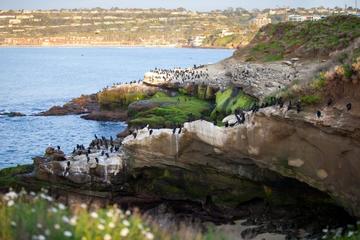
by Victor A. Walsh
In the winter silence, colossal shafts and spires and mesas of rock rise out of the early morning light as if they are giants glazed in mantles of stone. Their presence is daunting, otherworldly—something I feel implicitly but do not understand.
“The Navajo call Monument Valley Tsé Bií Ndzisgaíí. It means “The Clearing among the Rocks,” says Harry Nez, our soft-spoken, middle-aged guide from Navajo Spirit Tours.
Directly in front of us, towering above the snow-splattered dunes of red earth and patches of scrub are two imposing buttes called The Mittens.
 “It looks like a place where the dinosaurs once roamed frozen in a time capsule of volcanic rock,” I gasp.
“It looks like a place where the dinosaurs once roamed frozen in a time capsule of volcanic rock,” I gasp.
“Actually, the rocks are much older than the volcanoes,” says Harry. “Geologists say that they were formed from an ancient sea, but for us they represent the lives of the five-fingered people who came from the underworld.”
“On the left,” he says, pointing to the closer butte silhouetted black against the horizon, “you can see a man’s head frozen in stone. The long narrow column is his hand. On the right in the distance is East Mitten, which is the woman’s head and hand.”
“The bodies inside the earth,” he further explains, “are where the First People, the holy beings, came from. The hands are a reminder to us that the ancient ones will someday return.”
 Harry continues driving along the route made famous in John Ford’s classic film Stagecoach (1939) through an eerie, snow-dusted landscape of gouged, red-brown hills and gullies cradled by massive buttes. It’s as if nothing has changed since that time. There are no paved roads, power lines, restaurants or public restrooms — just a few scattered Navajo hogans veiled in gray mist. But everything, including the Navajo’s traditional way of life, is changing.
Harry continues driving along the route made famous in John Ford’s classic film Stagecoach (1939) through an eerie, snow-dusted landscape of gouged, red-brown hills and gullies cradled by massive buttes. It’s as if nothing has changed since that time. There are no paved roads, power lines, restaurants or public restrooms — just a few scattered Navajo hogans veiled in gray mist. But everything, including the Navajo’s traditional way of life, is changing.
The 27,000 square-mile reservation, the largest in the nation, is now in the throes of unprecedented crises: a two-decade long drought; an increasingly hotter and dryer climate, and waterways and wells polluted with radioactive waste from abandoned uranium mine tailings.
Rivers are flowing less often. Cottonwood and willow trees are vanishing. Shallow aquifers no longer have year-round water. Sacred springs and ceremonial and medicinal plants are disappearing along with eagles, cranes and bees. Raising sheep and other livestock, integral to traditional Navajo culture, has been declining for decades because of less forage and water. Since the late 1970s there has not been enough water from streams to grow crops.
 Navajo elders remember snows from the 1940s that were chest high on horses. They mention grass so thick and tall that sheep could get lost in it and soil that stayed damp through spring. It was a world they understood and identified with, but weather patterns now are extreme and unpredictable with no seasonal order. “The wind today is different,” says Janis Perry. “It is upset with us. You can see it in our sheep. They are constantly fatigued.”
Navajo elders remember snows from the 1940s that were chest high on horses. They mention grass so thick and tall that sheep could get lost in it and soil that stayed damp through spring. It was a world they understood and identified with, but weather patterns now are extreme and unpredictable with no seasonal order. “The wind today is different,” says Janis Perry. “It is upset with us. You can see it in our sheep. They are constantly fatigued.”
There is less snow pact now, warmer spring months, and more wildfires, insects and dust storms. The latter bury everything, transforming once viable rangeland into desert expanses, especially in the arid southwestern part of the Nation. What is unprecedented and alarming is that the sand dunes and sheets, a typographical feature for thousands of years, are now moving because of sparse vegetation and stronger winds. As they grow and move, local ecosystems are destabilized and disappear, and opportunistic plants such as the rootless Russian thistle or tumbleweed move in.
 All of this eludes me in winter’s cocoon at an elevation of 5,200’. In the afternoon light, the red-rock spires and mesas, sculpted in such a cacophony of shapes, rise above the dust-laden emptiness. They stand alone, as if haunted. North of Totem Pole, the wind hurls sand through twisted juniper trees and across the dusty road, gullies, dunes and knolls of fractured rock. As the sun fades, the horizon of misshapen rock formations looks eerily beautiful in the whirling wind.
All of this eludes me in winter’s cocoon at an elevation of 5,200’. In the afternoon light, the red-rock spires and mesas, sculpted in such a cacophony of shapes, rise above the dust-laden emptiness. They stand alone, as if haunted. North of Totem Pole, the wind hurls sand through twisted juniper trees and across the dusty road, gullies, dunes and knolls of fractured rock. As the sun fades, the horizon of misshapen rock formations looks eerily beautiful in the whirling wind.
Unlike at lower elevations, climate change manifests itself differently in Monument Valley. Even before the drought began in 1994, there was little if any snow pact on the mesa tops while the water level of the nearby San Juan River, a major tributary of the Colorado River, drops about two inches per decade due to declining snow melt.
But no one, as Garry Holiday, owner of Navajo Spirit Tours, reminds me, can accurately forecast weather patterns. This past winter the snowfall was surprisingly deep. Snow melt seeping through sandstone aquifers replenished countless springs through most of this summer, including the four surrounding Rain God Mesa that are used in Navajo healing and rain-making ceremonies
 To the Navajo, Monument Valley, the first tribal park in the United States, is more than a park or nature preserve. It is one of the spiritual centers of their ancestral homeland, a living link to their culture and identity, quite separate from Ford’s mythic Westerns. Some visitors are drawn by the landscapes they remember from his movies, but Navajo guides instead share stories about the Holy Ones, healing ceremonies, rock art and their clans.
To the Navajo, Monument Valley, the first tribal park in the United States, is more than a park or nature preserve. It is one of the spiritual centers of their ancestral homeland, a living link to their culture and identity, quite separate from Ford’s mythic Westerns. Some visitors are drawn by the landscapes they remember from his movies, but Navajo guides instead share stories about the Holy Ones, healing ceremonies, rock art and their clans.
“When I am away from here for a long time and come back here, I always shed tears,” says Harry. “But they are tears of joy. It is my connection to who I am as a Navajo.”
 “Monument Valley has an unusual power that anchors us,” Garry explains. “There is an inner harmony, beauty and peace. Navajo and non-Navajo, who come here, have been healed emotionally and physically. In our history, no invaders could come in and conquer it.” This included the brutal ‘Long Walk’ of 1863-1864 when the U.S. army under Colonel Kit Carson invaded and forcefully relocated thousands of Navajo people to a New Mexico wasteland called Bosque Redondo. Many of those who escaped capture found refuge in the valley.
“Monument Valley has an unusual power that anchors us,” Garry explains. “There is an inner harmony, beauty and peace. Navajo and non-Navajo, who come here, have been healed emotionally and physically. In our history, no invaders could come in and conquer it.” This included the brutal ‘Long Walk’ of 1863-1864 when the U.S. army under Colonel Kit Carson invaded and forcefully relocated thousands of Navajo people to a New Mexico wasteland called Bosque Redondo. Many of those who escaped capture found refuge in the valley.
What I felt earlier, I now begin to understand. Without these marvels of stone, no Navajo stories of creation, legends, songs or cultural memory would exist. They offer a sense of stability and permanence, even though in the scale of geologic time, I know that they are anything but. But that is not the point. It is their meaning to us that matters.
Looking at the sheer, red-rock faces, I feel a living presence with the past. It is embedded in the rock art of the ancient Anasazi, the fossils of plants and animals, and the aquifer-rock formations that channel water to sacred springs.
 With its hidden burial sites and surreal rock formations infused with gods and spirits and the Navajo presence, Monument Valley is unlike any other place that I have visited. This becomes clear to me later when Harry, Dick and I drive to Ear of the Wind, a tunnel-like vaulted rock arch that opens up to the sky, where echoes from the wind can be heard. In my mind, it resembles a cave where a giant once stayed to watch his kingdom.
With its hidden burial sites and surreal rock formations infused with gods and spirits and the Navajo presence, Monument Valley is unlike any other place that I have visited. This becomes clear to me later when Harry, Dick and I drive to Ear of the Wind, a tunnel-like vaulted rock arch that opens up to the sky, where echoes from the wind can be heard. In my mind, it resembles a cave where a giant once stayed to watch his kingdom.
Harry motions to us to sit a short distance away beneath another arch called Big Hogan. He tells us that giants long ago came here to talk to the coyotes, rabbits and other animals about what would be best for the world.
While listening, I stare up at the vaulted sandstone walls stained with black streams of water called desert varnish. The narrow vent or hole at the top, beaming like a lantern of white light, casts a golden glow across the rock.
 Then a long sonorous cry pierces the silence. Maybe fifty or sixty feet away, we see a young Navajo chanter sitting on a rock ledge. He breathes deeply and then leaning forward, rocks his body back and forth as his high-pitched voice echoes off the canyon walls.
Then a long sonorous cry pierces the silence. Maybe fifty or sixty feet away, we see a young Navajo chanter sitting on a rock ledge. He breathes deeply and then leaning forward, rocks his body back and forth as his high-pitched voice echoes off the canyon walls.
I do not know what the chant in Navajo signifies, except that it is harrowing, full of sadness, perhaps about the ongoing drought, and then calming, soothing, perhaps reflecting his hope for rain to water the land again.
As I look up at the vaulted rock, the chanting softens as it drifts through the sky hole into the other world.
If You Go:
Getting There:
♦ Monument Valley is located within the Navajo Nation, 170 miles northeast of Flagstaff, AZ on the Arizona-Utah border. Farmington, NM and Flagstaff are the nearest municipal airports. Local airports exist at Monument Valley, Kayenta and Page, AZ; Cortez, CO and Moab, UT.
Getting Around:
♦ The best way to get to Monument Valley is by car. The park’s entrance is in Utah. From Flagstaff (178 miles) head east on I-40 to US-89 N and follow US-160 E to US-163 N. (Kayenta exit) to Monument Valley Rd. in Olijato Monument Valley. US-163 links to US-191 in Utah. From Farmington (156 miles), head west on W. Broadway, take US-64 W and US-160 W to Monument Valley Rd.
Attractions:
♦ Monument Valley is a magical place for photographers and other outdoor enthusiasts. Along with taking a half-day or full-day tour with a Navajo guide, visitors can stargaze, hike Wildcat Trail, visit the intriguing Valley of the Gods and Goosenecks State Park in San Juan County north of the valley, or drive the scenic section of US-163 to the historic town of Bluff, UT.
Accommodations:
♦ Overlooking the spectacular Oljato-Monument Valley, Goulding’s Lodge is an historic icon, famous for its association with director John Ford’s Old West movies. The museum, once Harry Goulding’s trading post, offers a glimpse into that bygone era. The lodge has a dining room, gift shop, cabins, campground and small theater where guests can watch Ford’s westerns.
♦ Adjacent to the park’s visitor’s center and Navajo-owned, The View Hotel provides breathtaking views of the valley floor, especially the Mitten Buttes. Along with a restaurant, campground and cabins, it has a trading post unlike any other that features Navajo jewelry, earthen pottery, woven baskets and one of the largest rug collections within the Four Corners.
For More Information:
♦ Monument Valley Navajo Tribal Park has information on fees, camping, and tours.
♦ American Southwest provides information on the landscape, accommodations, and the valley’s 17-mile dirt-road scenic drive.
♦ Award-winning Navajo Spirit Tours features a beautiful photographic expose of the land, the Navajo guides and tours offered by the company.

Monument Valley and Navajo Indian Reservation
About the author:
Victor A. Walsh spends his time when he’s productively unemployed prowling forgotten or unusual destinations looking for stories that connect a place and its people to their remembered past. His historical essays and travel stories have appeared in the Christian Science Monitor, American History, Literary Traveler, California History, Journal of the West, Rosebud, Desert Leaf, among other publications.
Photos by Richard Miller (1-7), Scott Laws (8) and Richard Miller (9)
West Mitten (L), East Mitten in the foreground, and Merrick Butte (R)
The vaulted sandstone walls of Big Hogan
The spiral-sculpted monolith called Totem Pole
Spearhead and Rain God Mesas cradle the distant spires of Yhe Bi Chei and Totem Pole
Ear of the Wind
Monument Valley veiled in a mantel of morning fog
Merrick Butte (L) on the historic route used in John Ford’s film Stagecoach
The Three Sisters
The Thumb surrounded by wind-tossed sand dunes




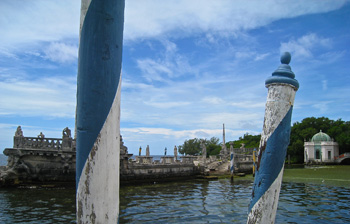 Vizcaya was designed with an open central courtyard, surrounded by four towers. Although the exterior duplicates 18th century Italian architecture, the building was constructed with 20th century techniques to adapt to Miami’s subtropical climate. Deering was a trained engineer and insisted on a concrete structure with steel-enforced floors to combat humidity, decay, and termites. He included modern features such as an elevator, telephones, and an “annunciator” to beckon servants from anywhere in the house.
Vizcaya was designed with an open central courtyard, surrounded by four towers. Although the exterior duplicates 18th century Italian architecture, the building was constructed with 20th century techniques to adapt to Miami’s subtropical climate. Deering was a trained engineer and insisted on a concrete structure with steel-enforced floors to combat humidity, decay, and termites. He included modern features such as an elevator, telephones, and an “annunciator” to beckon servants from anywhere in the house.
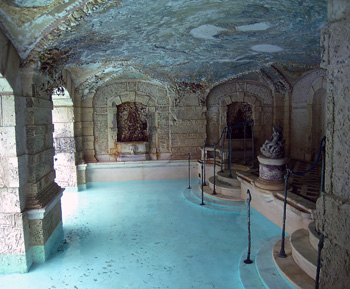 Deering was a renowned and extravagant host. His many guests included actress Lilian Gish, Henry Ford, and President Warren G. Harding. He placed a concrete barge in the bay and used gondolas or motor boats to transport guests for tea and cocktails. He also arranged for concerts and fireworks from the barge, and guests would watch from the shore. Originally, in true Venetian manner, the barge and gardens were accessed by canals. Deering would guide visitors through the canals, ending at the barge or the nearby gazebo.
Deering was a renowned and extravagant host. His many guests included actress Lilian Gish, Henry Ford, and President Warren G. Harding. He placed a concrete barge in the bay and used gondolas or motor boats to transport guests for tea and cocktails. He also arranged for concerts and fireworks from the barge, and guests would watch from the shore. Originally, in true Venetian manner, the barge and gardens were accessed by canals. Deering would guide visitors through the canals, ending at the barge or the nearby gazebo.
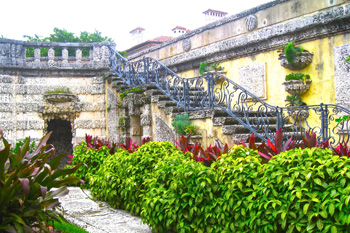 Deering also wanted formal European gardens, adapted to the Florida climate and flora. The garden design included Deering’s favorite flower, orchids, with 2,000 specimens placed throughout the estate, and now in the new David A. Klein Orchidarium. The gardens were completed in 1923. Deering would only live for two more years to enjoy his magnificent estate. Suffering from pernicious anemia for years, he died on a steamship returning from Paris in 1925.
Deering also wanted formal European gardens, adapted to the Florida climate and flora. The garden design included Deering’s favorite flower, orchids, with 2,000 specimens placed throughout the estate, and now in the new David A. Klein Orchidarium. The gardens were completed in 1923. Deering would only live for two more years to enjoy his magnificent estate. Suffering from pernicious anemia for years, he died on a steamship returning from Paris in 1925.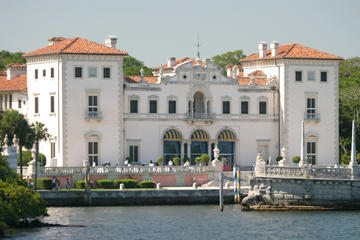
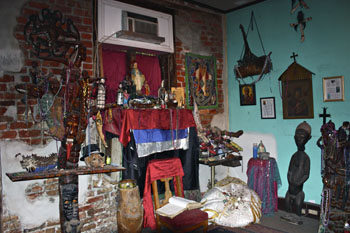
 Statues of saints seemed more out of place than the skeletons because this was no church. Then there were the voodoo dolls. Voodoo practitioners believe that voodoo dolls don’t just represent someone but actually become that person when a personal item such as a lock of hair or fingernails is added.
Statues of saints seemed more out of place than the skeletons because this was no church. Then there were the voodoo dolls. Voodoo practitioners believe that voodoo dolls don’t just represent someone but actually become that person when a personal item such as a lock of hair or fingernails is added.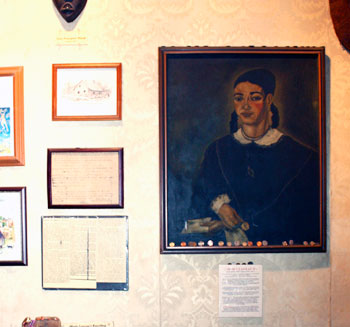 Our education continued when our tour guide reported that New Orleans voodoo is synonymous with voodoo queen Marie Laveau (1793-1882), whom he referred to as a free woman of color. NU’awlons pointed up at her picture on the wall as we left the museum to begin the walking tour. She was at the height of her power/influence in the 1850s. Although she was not psychic she had built up that reputation by collecting gossip when she visited various houses in the French Quarter to braid women’s hair.
Our education continued when our tour guide reported that New Orleans voodoo is synonymous with voodoo queen Marie Laveau (1793-1882), whom he referred to as a free woman of color. NU’awlons pointed up at her picture on the wall as we left the museum to begin the walking tour. She was at the height of her power/influence in the 1850s. Although she was not psychic she had built up that reputation by collecting gossip when she visited various houses in the French Quarter to braid women’s hair.
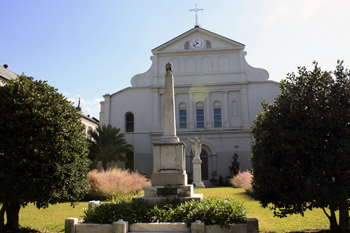 Our first stop was the St. Louis Cathedral but not to visit the interior. Instead we walked outside to the rear of the building where we found a small garden fenced off from the public. Peering through the wrought iron fence we saw a statue of Christ with raised arms. Marie Laveau was a member of this church congregation and she was known to perform voodoo rituals in this garden.
Our first stop was the St. Louis Cathedral but not to visit the interior. Instead we walked outside to the rear of the building where we found a small garden fenced off from the public. Peering through the wrought iron fence we saw a statue of Christ with raised arms. Marie Laveau was a member of this church congregation and she was known to perform voodoo rituals in this garden.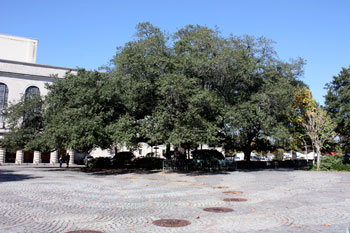 We crossed Basin Street and entered the neighborhood of Treme to visit Congo Square in Louis Armstrong Park. Creole slave owners strictly enforced the practice of Catholicism but the slaves circumvented this by gathering at Congo Square each Sunday (their one day off during the week under the Code Noire) to sing and gyrate to the rhythm of drum beats. They also participated in voodoo rituals.
We crossed Basin Street and entered the neighborhood of Treme to visit Congo Square in Louis Armstrong Park. Creole slave owners strictly enforced the practice of Catholicism but the slaves circumvented this by gathering at Congo Square each Sunday (their one day off during the week under the Code Noire) to sing and gyrate to the rhythm of drum beats. They also participated in voodoo rituals.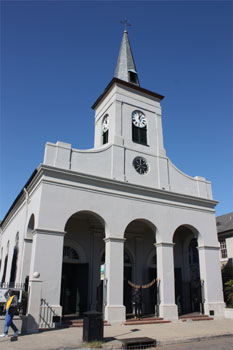 After you find your inner beat, leave Congo Square and visit the nearby Our Lady of Guadalupe Chapel. This church boasts a number of local voodoo practitioners among its congregation but you likely will not be able to identify them because they look just like anybody else.
After you find your inner beat, leave Congo Square and visit the nearby Our Lady of Guadalupe Chapel. This church boasts a number of local voodoo practitioners among its congregation but you likely will not be able to identify them because they look just like anybody else.
 Exit the Chapel and proceed to St. Louis Cemetery #1. The living is admitted free but the families of the dead must pay to maintain the upkeep of all the above-ground tombs that surround you. The French had a custom of interring people above ground because they did not want to have buried coffins rising to the surface and falling open because of the high water table and flooding for which the Crescent City is famous. With a little imagination you have the making of a good horror movie where the zombies rise from the open coffins in search of the living.
Exit the Chapel and proceed to St. Louis Cemetery #1. The living is admitted free but the families of the dead must pay to maintain the upkeep of all the above-ground tombs that surround you. The French had a custom of interring people above ground because they did not want to have buried coffins rising to the surface and falling open because of the high water table and flooding for which the Crescent City is famous. With a little imagination you have the making of a good horror movie where the zombies rise from the open coffins in search of the living.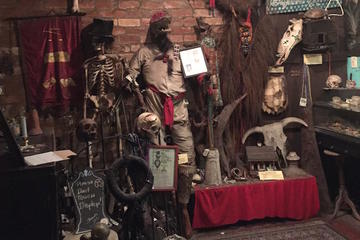

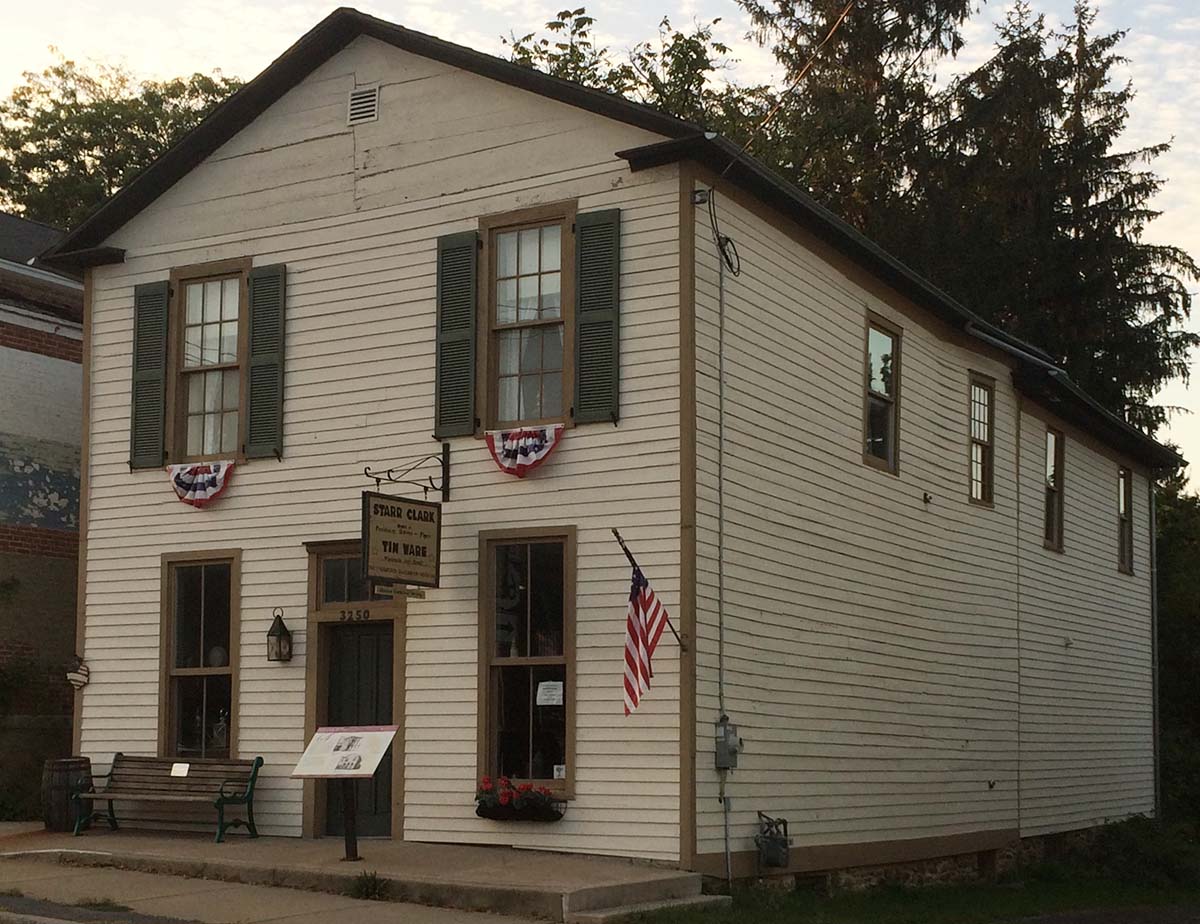
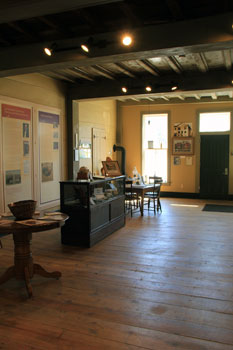 Walking through each room of Clark’s Tin Shop, I was able to take all the time I wanted, looking at many historic items and reading through so much fascinating information about the people and clandestine movement of the time.
Walking through each room of Clark’s Tin Shop, I was able to take all the time I wanted, looking at many historic items and reading through so much fascinating information about the people and clandestine movement of the time.
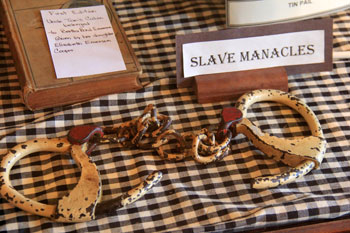 Starr Clark and his wife offered a temporary haven to fugitive slaves, in the attic of their home. They gave families, desperate for freedom, directions and solid contacts to the lake ports of Oswego, Cape Vincent, Port Ontario and Sackets Harbor. Once there, each could secure passage to Canada and a new life.
Starr Clark and his wife offered a temporary haven to fugitive slaves, in the attic of their home. They gave families, desperate for freedom, directions and solid contacts to the lake ports of Oswego, Cape Vincent, Port Ontario and Sackets Harbor. Once there, each could secure passage to Canada and a new life.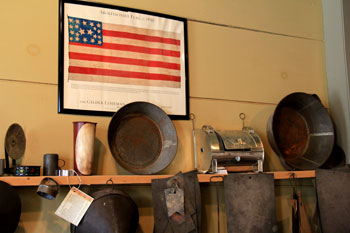 The gentleman was writing the United Herald newspaper, letting the editor know how two fugitive slaves, Williams and Scott, had made their way to the safety of Canada, thanks, in part, to Starr Clark.
The gentleman was writing the United Herald newspaper, letting the editor know how two fugitive slaves, Williams and Scott, had made their way to the safety of Canada, thanks, in part, to Starr Clark. The tin shop today is set up to show how things were way-back-when. A good tinsmith could fashion a tin pan in less than 20 minutes.
The tin shop today is set up to show how things were way-back-when. A good tinsmith could fashion a tin pan in less than 20 minutes.

 Usually in such a place, you may only view rooms from a doorway and snap a photo, so imagine my delight to find that for the same price as the Best Western a few blocks away, you can spend the night in this piece of living history.
Usually in such a place, you may only view rooms from a doorway and snap a photo, so imagine my delight to find that for the same price as the Best Western a few blocks away, you can spend the night in this piece of living history. Mr. Bandini was known for both his huge parties, and his political involvement. Guests travelled long distances to attend his famous 3 day fandangos involving food, drinks, music and a favorite of Mr. Bandini’s, dancing. Though known as a gracious host, it was not all fun and games for Juan Bandini. Many important political meetings that shaped the history of California were held right here in the salon. Here, along with other prominent Californios, Bandini planned revolts against more than one Mexican ruler of the day. During the Mexican-American war Juan Bandini was an American supporter and this home was the headquarters for Commodore Stockton. It was here that scout Kit Carson was sent by General Kearny to request aid in the battle of San Pasqual.
Mr. Bandini was known for both his huge parties, and his political involvement. Guests travelled long distances to attend his famous 3 day fandangos involving food, drinks, music and a favorite of Mr. Bandini’s, dancing. Though known as a gracious host, it was not all fun and games for Juan Bandini. Many important political meetings that shaped the history of California were held right here in the salon. Here, along with other prominent Californios, Bandini planned revolts against more than one Mexican ruler of the day. During the Mexican-American war Juan Bandini was an American supporter and this home was the headquarters for Commodore Stockton. It was here that scout Kit Carson was sent by General Kearny to request aid in the battle of San Pasqual.
 Heading upstairs and walking along the expansive 2nd story veranda overlooking San Diego’s old town, it’s easy to daydream about what life might have been like in the hotels’ heyday. Close your eyes as the dry dust rises in small clouds from the dirt streets below. Listen for the clatter of the horses pulling the stagecoach up in front of the hotel to unload passengers, weary from the 35 hour passage from Los Angeles. Imagine the laughter of the saloon crowd, the bustle of the town, and the rustle of crinolines as women pass on their way to the haberdashery.
Heading upstairs and walking along the expansive 2nd story veranda overlooking San Diego’s old town, it’s easy to daydream about what life might have been like in the hotels’ heyday. Close your eyes as the dry dust rises in small clouds from the dirt streets below. Listen for the clatter of the horses pulling the stagecoach up in front of the hotel to unload passengers, weary from the 35 hour passage from Los Angeles. Imagine the laughter of the saloon crowd, the bustle of the town, and the rustle of crinolines as women pass on their way to the haberdashery. Opening the faux finished door from the veranda reveals a room filled with period furnishings. A globe shaped lamp, fashioned after the old kerosene style, sits on the table beside the dark, ornately carved bed. Wallpaper, in vintage patterns of leaves and vines form a backdrop for the thick red velvet curtains trimmed with large gold tassels. Double hung, wood framed windows on either side of the door look out onto the veranda and the town below. Each room has its own characters and features, like fireplaces or sitting rooms, though you will not find a TV in the room to distract from the authenticity of the place. The comfy cotton quilt seems like a perfect place to curl up with a book.
Opening the faux finished door from the veranda reveals a room filled with period furnishings. A globe shaped lamp, fashioned after the old kerosene style, sits on the table beside the dark, ornately carved bed. Wallpaper, in vintage patterns of leaves and vines form a backdrop for the thick red velvet curtains trimmed with large gold tassels. Double hung, wood framed windows on either side of the door look out onto the veranda and the town below. Each room has its own characters and features, like fireplaces or sitting rooms, though you will not find a TV in the room to distract from the authenticity of the place. The comfy cotton quilt seems like a perfect place to curl up with a book. When Seeley built his grand stagecoach hotel with 20 guestrooms in 1869, it may surprise you to learn that it did not include indoor plumbing. Chamber pots and outhouses were the facilities of the day. Indoor plumbing was not added until 1930. Don’t worry though, although the 2010 restoration, overseen by teams of experts and historians, included the use of as much of the original materials as possible, the bathrooms are not original. The 20 rooms were converted into 10 unique guestrooms, accommodating guest bathrooms that include pull chain toilets, pedestal sinks, modern rain head showers and in some cases antique copper or wooden soaker tubs. It still has that 1880s feeling but with all the modern conveniences.
When Seeley built his grand stagecoach hotel with 20 guestrooms in 1869, it may surprise you to learn that it did not include indoor plumbing. Chamber pots and outhouses were the facilities of the day. Indoor plumbing was not added until 1930. Don’t worry though, although the 2010 restoration, overseen by teams of experts and historians, included the use of as much of the original materials as possible, the bathrooms are not original. The 20 rooms were converted into 10 unique guestrooms, accommodating guest bathrooms that include pull chain toilets, pedestal sinks, modern rain head showers and in some cases antique copper or wooden soaker tubs. It still has that 1880s feeling but with all the modern conveniences. Leaving the hotel to explore, you are just steps from museums, interpretative displays artisans, shops, restaurants, and a theater. When night falls and the park closes, you are left with unique access to Old Town, to quietly contemplate what it was like for those early settlers of the Wild West.
Leaving the hotel to explore, you are just steps from museums, interpretative displays artisans, shops, restaurants, and a theater. When night falls and the park closes, you are left with unique access to Old Town, to quietly contemplate what it was like for those early settlers of the Wild West.
